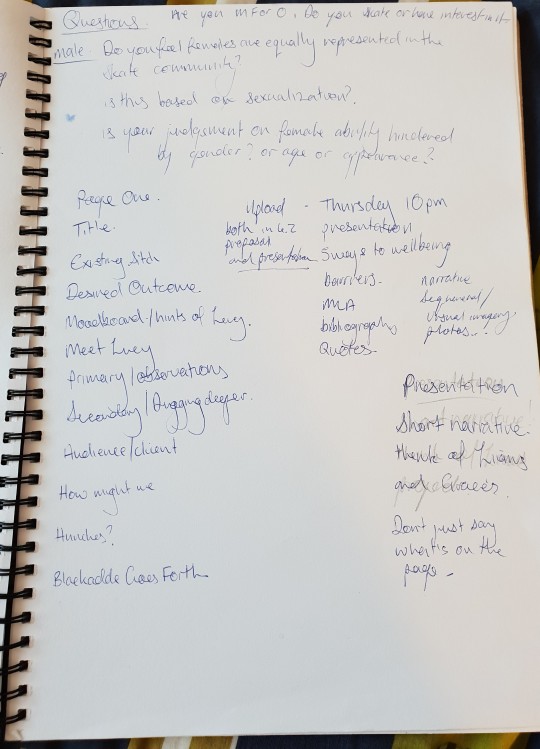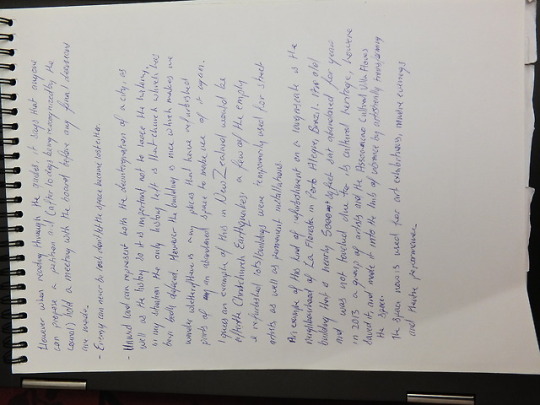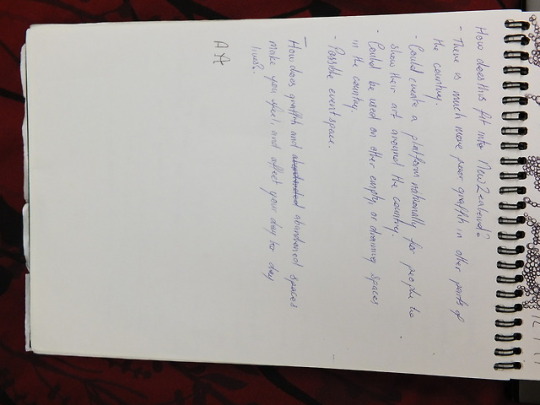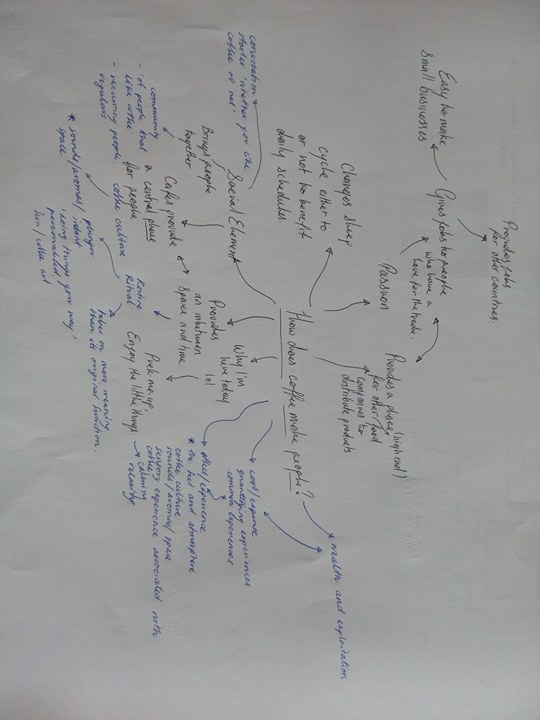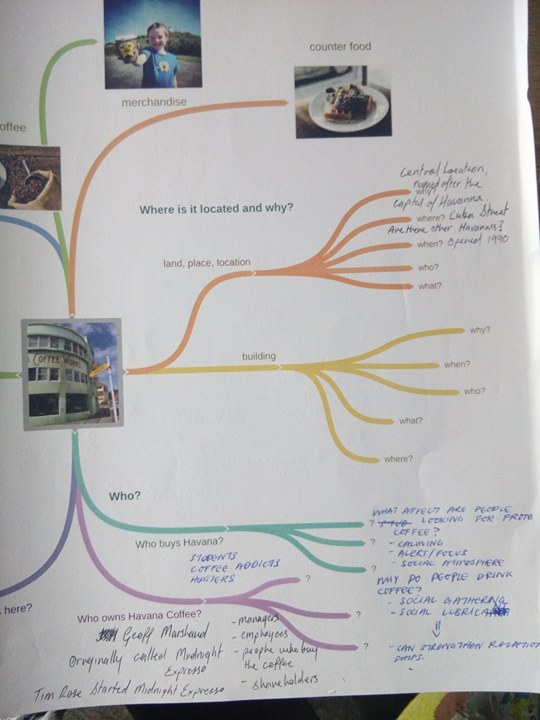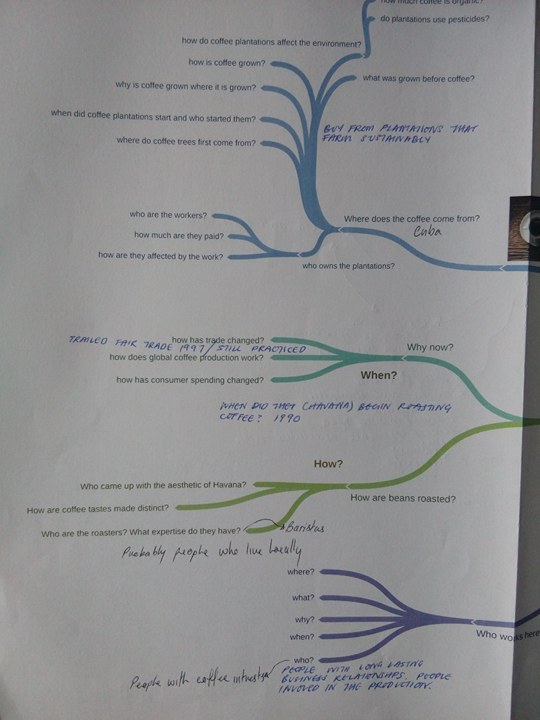Photo

Week 7:
For our next assignment we are to create something that exists outside of technology and using code to do so. I have begun by making a list of ideas that could be used to make my final piece. The ones that interest me the most are the using sound or data / statistics as an input, and sound or patterns as an output. I can’t really decide on what technology I’m going to use before I have decided what I would like to make.
0 notes
Text
Final Response
My overall goal in this investigation was to look into how we can change one abandoned area in Wellington in particular (corner of Taranaki and Frederick Street), and by extension what could be done to other areas like this in Wellington.
Throughout both of my investigations I learnt a lot about the history of Wellington’s Chinatown, and also on how people feel about abandoned spaces within Wellington. During the research phase of my investigation (and just through my daily life) I’ve noticed that there are many of similar spaces like the one on Frederick Street, as well as coming from Christchurch I’d noticed the same. I’ve always thought that it’s a waste of space and that these places have a lot of potential.
My human based investigation showed me that many other people around Wellington feel the same way about some of these places, but feel like they don’t have enough of a voice to do anything about it. On the other hand, my text based research showed me examples of people who have banded together to refurbish old spaces into something that can be publically enjoyed. The text research also gave me an insight in to the history of the area, including the old Chinatown, and how different communities were affected.
If I were to start my investigations from scratch, there are a few things that I would do differently. Firstly I would stay on top of my work a bit better and aim to manage my time more sufficiently.
Another thing I would change that is more related to my investigations would be a more thorough human based in investigation. I feel as thought going to social media and other websites to pose some of these questions would give me a better and wider view on how people feel about the area, or other similar areas. I also feel as though I was too open with my text based investigation. I definitely found out some things that I didn’t even know about about prior, however that is just the tip of the iceberg. Had I set out with some more refined questions, I probably would’ve gotten some more useful information. I am still uncertain as to a lot of details about the Chinatown era and what happened. The last thing I would change would be to refer to the values and ethical guides.
If I were to continue with this investigation and take it to the next step, the first thing I would do is start talking to my friends and other communities before going to the council to start a petition. I would look into the historical structure of the Chinese mission hall, as well as the grounds itself and begin planning what could be done to the space instead. The historical side of the space is very important and should be considered in the forefront of my mind when taking it further as it is the foundation of the land. The Chinese aspect would even give more, and more meaningful ideas as to how we could design the space. Should the petition get approved by the council, I would then refer to some of my colleagues in the design field and being making mockups of how the area could look, and what it could be used for.
0 notes
Text
Response to Text Investigatio
Looking into the facts surrounding the abandoned area on the corner of Taranaki and Frederick Street, I have been able to conduct a text based investigation as to what was there, what is there, and what could be there.
Quite by chance I’ve learnt a lot about the old Chinatown of Wellington through my text research. The early settlers of from China came to Wellington just after an Earthquake raised the land in 1855. Between the 70s and 80s the land which is now the empty lot grew into a buzzing hub for the Chinese people in New Zealand and became what was known as Chinatown. Chinatown mainly consisted of Hainings Street, and a bit of Frederick Street and in 1905 one of the only two Chinese mission halls was built. Although there was a large rise in activity and markets in the Chinatown district, not everyone was happy about the way Wellington was looking. The Chinese community in Wellington was not treaty very kindly and were heavily policed, yet nothing out of the ordinary was ever found. On top of the heavy policing, there was often general racism towards the Chinese people, as well as multiple stories spread in the streets, saying that the Chinese would kidnap children and boil them. The worst case of racism towards the Chinese community was on the 24th of September 1905 when Lionel Terry shot dead Mr Joe Kum Young with a revolver before turning himself in. His reasoning for this was that he believed to be ridding the country of ‘yellow peril’. This resulted in Terry getting the death penalty, but skimming past it and being declared schizophrenic and spending the rest of his days in a mental institution.
The hall itself is quite interesting too. When it was first build in 1905, it served as the Chinese mission hall and was later welcomed / joined by the Anglican church. Nowadays the hall is the only remaining artefact from the Chinatown era which really captures the essence of the area, rundown as it may be. It’s noteworthy that the structure of the hall is still standing and remains unchanged to this day, other than some slight reinforcements a could of years ago. Though it is still standing, the hall has nearly completely run its course as it now sits isolated in the empty lot with broken windows and graffitied walls. Keeping the cultural heritage in mind, I think that it would be a great waste of time and history if we were to destroy the hall; instead I think that there is a way to engage multiple communities in the space.
As well as looking in to the history of the area itself, I have looked into some other places around the work that have refurbished rundown sights into something new and creative for the public to enjoy. Two notable examples of this would be firstly in the neighbourhood of the La Floresta in Brazil where an old building (standing at nearly 5000 square feet) sat abandoned for years and was not touched due to its cultural heritage. This was until in 2013 a group of artists and the Association of Cultural Villa Flores turned it into a vibrant space that has since been used to hold multiple art exhibitions, and live performances. The second example of this is the church of Santa Barbara that has been refurbished into an indoor skatepark. The church is personally the most interesting to me as it shows that the original structure can be reused as well as adding on a personal touch to it. The church was built in 1912 but had since been left to deteriorate. Until in 2007, Redbull and some crowdfunding pooled together and restructured the building, and turned it into an indoor skatepark. The skatepark was then decorated and painted by a well known Madrid street artist. This kind of thing is a great opportunity for something new and exciting like an attraction to be built, while still keeping the original structure and heritage of the building. It also provides a chance for local artists to help work on the project.
But what can I actually do about the space? The biggest issue with my investigation is the ownership of the land. Because the area has been left abandoned and unused, the council can’t really do too much with it. I have emailed them to find out what can be done and unfortunately they are not allowed to disclose the information as to what was there before, who owns the land, nor their plans for it. However I am able to start a petition that can then be taken to have a meeting with 5 representatives of the Wellington Council if I’m really serious about it.
This variety of information that I have collecting has helped me understand more about the history of the space, and what has happened to it. It has also given me an insight as to what we can do about it and how do go about it. One of the main things that I have taken from this research is that in no circumstances should we fully dismantle the old Chinese Mission Hall. The hall is one of the only remaining artefacts of Chinatown, and knowing this has slightly furthered my aims in this investigation to not only making the space a nicer place, but reestablishing that historic Chinese connection. I think that the space is full of potential and could be quickly turned around into something that can be enjoyed by the public on a range of levels, either walking through, running past or driving past on your way to work.
0 notes
Text
Late upload for week 8 independent studies
The place I would like to investigate / change is the empty space on the corner of Taranaki Street and Frederick Street.
I would like to turn the space into a more public friendly space, as well as a space that can be used with and interacted with daily by everyone.
To gather more information on this topic I could ask at the city council what is currently being done with the space and what their plans are for it.
To understand how the public currently feels about the space and what they would like done with it / how it could be interacted with I could stand by the spot at peak times where people pass it and ask passerbys a few questions.
In this investigation my aims are to transform the empty space (above) into something that isn’t an eyesore, doesn’t look dead and dangerous, and can be accessed by the public on a daily basis to improve their day.
My current thoughts are to turn it into a semi park place with benches and spots for reading or performances.
Performances could include plays, productions, art displays etc.
Alternatively I would like to turn it into a space where everyday people can display their art without running the risk of it being damaged, or needing the clout to get into an art show.
How can people interact with this space whether it be passing by or spending a while in the space?
How can this space benefit the community?
What communities will this space be able to benefit?
The way I will firstly go about answering these questions is likely to be getting people’s opinions and thoughts as they are passing the space.
To gain a better understanding of community perspectives I could access blogs of local wellington artists.
Again asking people who frequently pass by the spot
Post on neighbourly
Post on facebook/ social media to reach out to my peers.
0 notes
Photo

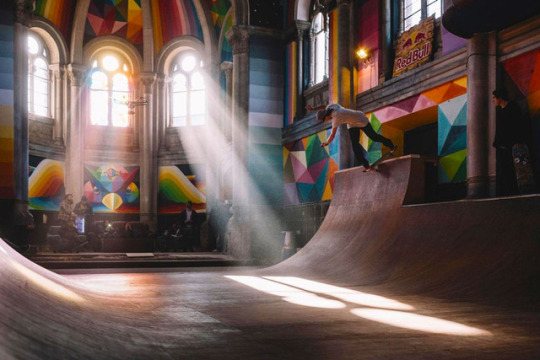


Images of inside the church in Spain, and of the old Chinese mission hall (plus the elevational drawings_
0 notes
Text
Text based investigation
The old china town was on the corner of Haining and Frederick Street by the abandoned church. The area was actually a swamp until the 1855 earthquake raised the ground, and within the next 20 years the street had become a buzzing area. It is interesting that multiple scholars of both Chinese and non Chinese cultural backgrounds have denied Chinatown even existing. Although the Chinatown was a buzzing community, they weren’t welcomed very well into the everyday life. Rumours were spread around the city that they would kidnap children and boil them, along with other similar tales. Once a month the Inspector of Nuisances would search the Chinese households, however never found a trace of anything remotely out of the ordinary. Though the profiling towards the Chinese continued.
http://www.stevenyoung.co.nz/index.php?option=com_content&task=view&id=149&Itemid=43
24 September 1905. Some of the racism even resulted in the murder of Joe Kum Yung, by the bullet of a revolver shot by Lionel Terry who then admitted to the crime saying that he was cleansing the city of ‘yellow peril’. He was sentenced to death, but ended up going to live in a mental institute and was diagnosed with schizophrenia.
https://nzhistory.govt.nz/race-killing-lionel-terry-murders-joe-kum-yung-in-haining-st-wellington
(Posted above are the elevation drawings of the original structure done by Frederick de Jersey Clere. The originals of these can be found at the Alexander Turnbull library in Wellington. )
This building used to be the Chinese mission hall. Nowadays it is the only remaining structure from the era where Chinatown thrived on Haining and Frederick Street. The church represented the relationship between the Chinese and the Anglican church.
From my research around the structure I have found that it is a significant part of the Chinese history in Wellington so it would be ashame if the structure were to completely disintegrate. It’s noteworthy that the actual building itself has been left unchanged over the years and kept to its original facade, although this also means that no general maintenance has been done either. Keeping this in mind, I want to focus my investigation on restoring the building in some way that honours the Chinese heritage, while also adding a new spin to the area.
“To the glory of God and the spread of His kingdom among the Chinese in this diocese this stone was laid by Frederick, Bishop of Wellington, December 6th 1905.”
http://wellingtoncityheritage.org.nz/buildings/1-150/124-chinese-mission-hall?q=
Earlier in my process I contacted the city council to see if they could tell me anything about the ownership of the land currently, nor could they tell me how to find out how to obtain such knowledge without breaching their set of values and morals. This is understandable so to find out what used to be there my only option are to sought out old photos of the street from before the buildings were taken down, or to ask my people I know who are native to Wellington and may have a better idea of the area.
Some other text based research I wrote by hand when my laptop was broken.
https://www.pps.org/article/how-to-bring-life-to-vacant-lots
Pls don’t fail me I’ve been working 38 hours a week and trying to do all of my uni work when I can
This abandoned church has been transformed into an indoor skatepark which I thought was pretty cool.
https://www.thelocal.es/20151216/amazing-transformation-of-abandoned-church-to
The old abandoned church of Santa Barbara in Spain has been transformed into a new colourful indoor skatepark. The original building was built in 1912, however had not been cared for and therefore had began to deteriorate. Until in 2007 Redbull and some crowdfunding pulled together and refurbished the area. To even add a little touch the well known Madrid Street artist painted the inside of the structure with a beautiful kaleidoscope pattern.
0 notes
Text
Response to human based in vestigation
On Wednesday of week 10, I stood out on the corner of Taranaki and Frederick Street to conduct my people based investigation. There were two parts to parts to this investigation, the first being recording a tally estimate of how many people passed the place, and the second being me striking up conversations with people walking past (I couldn’t quite flag down any cars).
For the tally results I went out to the corner every two hours for 15 minutes at a time. While I was out there, the first half of the 15 minutes was spent recording the number of people walking past, and the second half was spent recording how many cars passed the area. My times began at 8am, and ran through until 6pm.
Firstly the pedestrians tally. On average, the time when people most frequently walked past the area was around 8am (when I started conducting my investigation), 12.30ish, and 4.20ishpm. This was largely due to the number of Wellington High (and probably some Massey) students walking past either to school, on their lunch break, or when school had just finished. At first I thought that this meant that the results were semi biased, however it then struck me that it could provide an opportunity to do something student focused with the area, since they are most likely the ones to pass it.
The next part of this investigation was recording the cars, which was much more difficult than recording the people as many more cars (trucks and busses too) drive past. To balance my results out I only counted every 3rd car as one car. Unsurprisingly I found that the time of day where people are most likely to drive past are around the 8am mark, and later on towards 6pm when there was a real build up of traffic. People driving to and from work is most likely the reason for this, and these two times were miles ahead of the others as I actually kept losing count of the cars. This means that at roughly two stages of the day people are sitting in their cars at the lights with nothing to look at, and although this didn’t differ from what I had originally thought would happen, it gave me the idea that the area doesn’t necessarily have to be focused on art but instead having one or two large murals and re doing to the Chinese Hall might enhance the experience of driving past.
Finally the fun part; striking up conversations with random punters on the street. I dedicated Wednesday to strictly taking the tallies (in between doing other work), which meant I had to use Friday to carry out the oral surveys. A lot of people simply ignored me when I asked for a second of their time, however I did manage to chat with a few people and from that I have recorded a few select people from different backgrounds to give me a broader view on everyone that uses the space. Coincidentally Pio, a friend of mine, walked past the area holding his skateboard so naturally we had a yarn and he helped me out with my investigation. He usually passes the area twice or at least once a week on his way to Treetops, or just out for a street skate. Pio’s new to Wellington this year, but he said passing by makes him sad because it ruins the natural vibe of the city centre; that and ‘if they’re not going to put anything new or cool there, they may as well make it into a skatepark.’ Pio is 18 and a student. Slowly yet steadily, my next prey approached me. Janet’s the name, 82, retired and walks her dogs past thrice a week’s the game. When I asked her to describe how the empty area made her feel, she told me that it seems ‘cold’ (I thought that was a bit strange but I kind of get it) and that isn’t a pleasant experience, especially because of the graffiti. Next I managed to speak with two very different groups of students from Wellington High who I have left nameless. The first group were a larger group of slightly older students that said the space looked ‘bundy’ and another said ‘depressing’. However they don’t mind area staying how it is as they sometimes go down there to smoke during lunch, morning tea or when they’re not in class. I found their honesty quite funny. The next group was a much smaller group of only 3 people who were year 11 and said they don’t really notice the area, however they would like to see it become a recreational area for students with some form of interactions (donation book swap for example). The last person whose thoughts I recorded was a lady named Sian, who was 23. Sian walks past the space almost everyday of the week, and at late times on her way home from work which she said makes her feel incredibly unsafe. “If they don’t make it into something nice, it should at least have better lightning” she said, which is very valid as she doesn’t just walk down Taranaki street but down Frederick Street too.
I didn’t record everyone that I spoke with, and a large number of people wouldn’t stop to talk to me. What I found though, was that the majority of people don’t actually care what the space becomes, just so long as it gets changed in the near future. Some people believed that they should fully tear down the remainder of the hall to fully utilize the space, such as putting an apartment building there instead. Personally I feel as though it would be ethically wrong to pull down what remains of the Chinese hall, as it would be disrespectful towards the history of the land. Instead we could possibly revitalize the structure and build around it. This investigation is an example of how soft power can further my research as it gives me the human edge and emotion that I wouldn’t be able to get through books and the internet.
0 notes
Photo



Here are the results from carrying out my human based investigation. I took these results standing on the corner of Taranaki and Frederick Street on Wednesday and Friday of week 10.
0 notes
Text
Proposal for Investigation
Overview:
I am interested in changing the abandoned space on Taranaki and Frederick / Haining street and how I can change it into a more publically friendly place.
In this investigation my aims are to transform the empty space (above) into something that isn’t an eyesore, doesn’t look dead and dangerous, and can be accessed by the public on a daily basis to improve their day.
My current thoughts are to turn it into a semi park place with benches and spots for reading or performances.
Performances could include plays, productions, art displays etc.
Alternatively I would like to turn it into a space where everyday people can display their art without running the risk of it being damaged, or needing the clout to get into an art show. To gather more information on this topic I could ask at the city council what is currently being done with the space and what their plans are for it.
Background Research:
The old china town was on the corner of Haining and Frederick Street by the abandoned church. The area was actually a swamp until the 1855 earthquake raised the ground, and within the next 20 years the street had become a buzzing area.
Looking on the Wellington City Heritage website I found a documentation of the Chinatown’s history. Reading the text I found that the church building used to be the Chinese mission hall. Nowadays it is the only remaining structure from the era where Chinatown thrived on Haining and Frederick Street. The church represented the relationship between the Chinese and the Anglican church. After emailing the council, I found out that they are not actually allowed to disclose the history and the possession of the site and building. HOWEVER! I found on the website that the Chinese Mission began at that site in 1905, and ran until 1956 until A. Murdoch purchased the land. The space was used for the Frederick Street Light and Sound Association in 2009, but has been vacant and slowly deteriorating eversince.
http://wellingtoncityheritage.org.nz/buildings/1-150/124-chinese-mission-hall?q=
My Aim and Questions: My aim is to change the space from somewhere that is dead and empty to a space that has a positive atmosphere and can be used daily to brighten the public’s day.
Questions one: How does this space currently make the public feel?
Question two: What can I do to make this space better/ how to go about it?
How will I investigate these questions?
To understand how the public currently feels about the space and what they would like done with it / how it could be interacted with I could stand by the spot at peak times where people pass it and ask passerbys a few questions. I could look into other places around the world that have abandoned spaces that have refurbished them. For this particular question I will investigate how it makes different communities feel / affects them. To find out how to make people feel better about their space I will research into how other cities have revitalized parts of their towns that brighten their everyday lives. This question is more open ended so I can look into human emotions in general. I’ll look at some books on the human reaction.
Carrying out the investigation will mean looking into the history of the area more, as well as finding out the procedure that has to be taken before changes to a space can be made. My first step in this would be finding out what people want the space to be, probably then contacting the council and seeing what I have to do before I’m able to make changes to a space.
Treaty and Ethics:
Contacting the city council will not do any harm and will provide me with basic outlines of the information that I can gather ethically.
When looking into how the space makes people feel I will have to talk to people on the streets. I’ll have to be careful while doing this as not to disclose any personal information that could be potentially harmful. For the purposes of this question I will only record the first name, age, and possibly occupation of the people that I talk to. This touches on the values of Kai Tupato and Aroha by respecting the people who I am interviewing and their beliefs.
Mana and Mahiki relate to researching how people feel and what could make them feel better because it is important to respect and acknowledge how people feel, what makes them feel, and what they know on the subject even if I disagree with it. Changing the space also means honoring the original owners of the land, as well as the history of the land which relates to the first article of the Treaty.
0 notes
Text
Week 7 Independent Studies
In the Big Life Fix episode that dealt with Emma, Haiyan Zhang was looking to create something to help Emma, a person with Parkinson’s disease. Not only was Haiyan reaching out to Emma, her product was aimed to help the community of people with Parkinson’s in general as anyone with the disease could use the wristband to give them a slight improvement in their daily life. Haiyan accessed information through multiple means which helped her to gain a better understanding of the community she was trying to work with. The first way she collected information was by speaking with Emma. This allowed her to become more familiar with her, the disease, and how it affected her life on a personal level (the same can be said when she spoke with Emma’s boyfriend and family). She then met with a professor who studies Parkinson’s disease which allowed her to gain knowledge on the subject that regular people, or sources could not probably give her, as well as how the disease works in a technical way (what it is that causes the body to shake etc.) Similarly to talking with Emma, Haiyan also met with a group of people that had the disease which meant that she could then think about expanding her project to help more people within the community. Both meeting with Emma and with the group is an effective way to research the subject because it is impossible for Haiyan to know what it is like to live life with the disease since she does not have it. Lastly, she consulted a group of designers which meant she could get different views on her project and possibly be given some advice or opinions.
In the Calypso project reached out to the community of people who visit the aquarium, and the all of the sea turtles! (And other marvellous creatures of the sea.) I am unsure as to whether she effectively she accessed knowledge in these communities, however she obviously has done some research on the topic. Through creating the plastic bag turtle, she was able to draw a multitude of people with the similar thoughts and feelings towards polluting in the ocean. This created a pool of collective knowledge and allowed for people to communicate their ideas through conversation while contributing to building the turtle.
Communities that see the empty space on Taranaki street in a different light than me could consist of, but is not limited to:
People wanting to build on the spot
People who have a history with the spot
Homeless people
Drug dealers
Pedestrians
Drug users
People who litter
From where I am now, I would have a very close minded view on the space because I do not regularly access it. I have never been a homeless person seeking refuge, nor have I been a drug dealer (or user) who conducts business. I also would not have a very in depth knowledge of the people that use or pass by/through that space on a daily basis as I have never monitored that spot (other than walking past it occasionally).
0 notes
Text
Week independent studies
What makes the history of male sex in toilets a hard one to write about in New Zealand?
New Zealand has only recently become open to the LGBT community. Male toilets played a big part of the gay scene because
Police and bystander brutality
Illegal (at the time)
“Wasn’t noble”
Cruising spaces were made by gay men, not given to them.
The history is semi hidden, has to be accessed through people, archives, and history
Not always fully gay men
Prior to gay pubs
Decline in unisex bathrooms
LGBT
Transgender people are affected
Children
Homeless
Families(?)
Task two:
Originally used a derogatory term used to describe a manner that was low class, or pover, however is now used to refer to reusing materials to (gentrify) things without actually gentrifying something (or somewhere). This means that poorer areas can embrace artwork and such without a sudden rise in property prices.
it is used to deride the aesthetics of Mexican peasants, whose personal appearance and collective visual culture necessarily reflects crafting strategies of making do, repurposing, and assembling cast-off bits of other things.
Task 3:
To change a vacant building in Wellington I would need for first find out who is technically the owner of the land. Then I would need to contact them and if I cannot contact them I would contact the council to seek advice. Then I would need to come up with a plan as to what the building would want to be changed into. These plans would probably need to then be confirmed by the council.
0 notes
